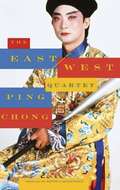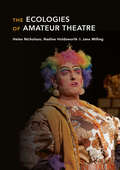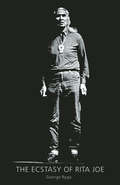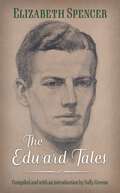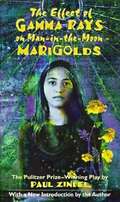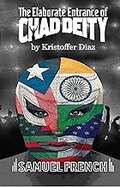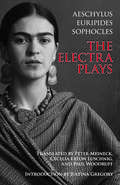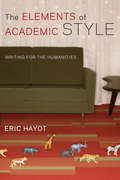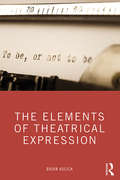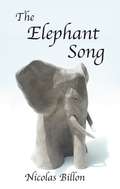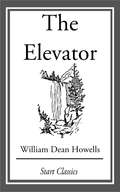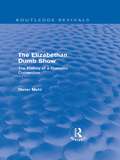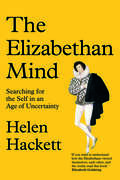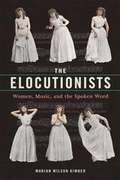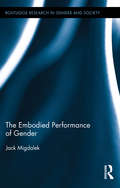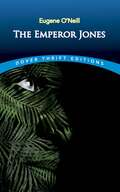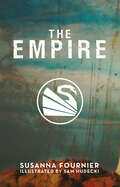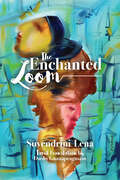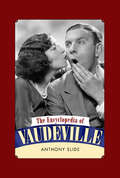- Table View
- List View
The East/West Quartet
by Jessica Hagedorn Ping ChongFor nearly three decades, Ping Chong and his company have written and staged some of the most innovative and arresting examinations of "the Other" on stages in the U.S., Europe, and Asia. His work more than any other artist has explored the ways Asian cultures have intersected with contemporary American society and throughout history.This volume collects four of his masterworks created over the past decade, including:Deshima (1990), a documentary collage of the history of the West and Japan;Chinoiserie (1995), spans centuries, continents and cultures, where the mysterious East meets the mysterious West;After Sorrow (1997), explores the legacy of war in Vietnam;Pojagi (1999), a poetic documentary on Korea from the sixteenth century to today.The Washington Post has said these works are "like poems in their simplicity and power to evoke . . . -carefully wrought and beautifully designed."As an artist , I'm an outsider in American society. As an experimental artist, I'm an outsider in the art world. As a person of color, I'm an outsider; as an immigrant, I'm an outsider; as a gay man, I'm an outsider. It's the position that fate has allotted me, but it's a valuable postion to be in, because I think every society should have a mirror held to it by the outsider."--Ping Chong, 1999Ping Chong was born in 1946 and raised in the Chinatown section of New York City. He began his theatrical career with Meredith Monk and later founded his own company in 1975, which later became Ping Chong and Company. It was created to explore the meaning of contemporary theatre and art on a national and international level. He has created over fifty major works for the stage, including Humboldt's Current, Nosferatu, Kind Ness, and Undesirable Elements. His works have received numerous Obie and Bessie Awards and are performed throughout the world.
The Ecclesiazusae
by AristophanesAristophanes' "Esslesiazusae", written in the early 4th Century BC, marks a crossroads in his career. Post-dating the Peloponnesian War, it reflects a late change in his writing and a much changed society. This edition includes the complete text.
The Ecologies of Amateur Theatre
by Nadine Holdsworth Helen Nicholson Jane MillingThis book is the first major study of amateur theatre, offering new perspectives on its place in the cultural and social life of communities. Historically informed, it traces how amateur theatre has impacted national repertoires, contributed to diverse creative economies, and responded to changing patterns of labour. Based on extensive archival and ethnographic research, it traces the importance of amateur theatre to crafting places and the ways in which it sustains the creativity of amateur theatre over a lifetime. It asks: how does amateur theatre-making contribute to the twenty-first century amateur turn?
The Ecstasy of Rita Joe
by George RygaRita Joe is a Native girl who leaves the reservation for the city, only to die on skid row as a victim of white men's violence and paternalistic attitudes towards First Nations peoples. As perhaps the best-known contemporary Canadian play and a poetic drama of enormous theatrical power, The Ecstasy of Rita Joe had a major influence in awakening consciousness to the "Indian problem" both in whites and Natives themselves.Cast of five women and 15 men. With a preface by Chief Dan George.The Ecstasy of Rita Joe premiered November 23, 1967 at the Vancouver Playhouse.
The Edward Tales
by Elizabeth SpencerIn conferring upon Mississippi native Elizabeth Spencer (1921–2019) the 2013 Rea Award for the Short Story, the jury said that at the then age of ninety-two, she “has thrived at the height of her powers to a degree that is unparalleled in modern letters.” Over a celebrated six-decade career, Spencer published every type of literary fiction: novels and short stories, a memoir, and a play. Like her best-known work, The Light in the Piazza, most of her narratives explore the inner lives of restless, searching southern women. Yet one mercurial male character, Edward Glenn, deserves attention for the way he insists on returning to her pages. Speaking of Edward in unusually personal terms, Spencer admitted a strong attraction to his type: the elusive, intelligent southern man, “maybe an unresolved part of my psyche.” In The Edward Tales, Sally Greene brings together the four narratives in which Edward figures: the play For Lease or Sale (1989) and three short stories, “The Runaways” (1994), “Master of Shongalo” (1996), and “Return Trip” (2009). The collection allows readers to observe Spencer’s evolving style while offering glimpses of the moral reasoning that lies at the heart of all her work. Greene’s critical introduction helpfully places these narratives within the context of Spencer’s entire body of writing. The Edward Tales confirms Spencer’s place as one of our most beloved and accomplished writers.
The Effect of Gamma Rays on Man-in-the-Moon Marigolds: A Drama in Two Acts
by Paul ZindelBeatrice was a mother...and the embittered ringmaster of the circus Hunsdorfer featuring three generations of crazy ladies living under the sloppiest big top on earth. Nanny was no problem. She sat and stared and stayed silent as a venerable vegetable should. Ruth was half-mad and easily bought with an occasional cigarette. But how is the world would Beatrice control Tillie--keeper of rabbits, dreamer of atoms, true believer in life, hope, and the effect of gamma rays on man-in-the-moon marigolds...<P><P> Pulitzer Prize Winner
The Elaborate Entrance Of Chad Deity
by Kristoffer DiazDramatic Comedy CHaracters: 5 male (1 non-speaking) Single Set Finalist for the 2010 Pulitzer Prize for Drama Winner! 2011 Obie Award for Best New American Play Winner! 2011 New York Times Outstanding Playwright Awards Winner! 2008 National Latino Playwriting Award Mace is a professional wrestler. He's a really good professional wrestler. He's not the champion though - that's the impossibly charismatic Chad Deity. When Mace discovers a young India
The Electra Plays
by Paul Woodruff Cecelia Eaton Luschnig Peter MeineckAeschylus: The Libation Bearers; Euripides: Electra; Sophocles: Electra
The Elements of Academic Style: Writing for the Humanities
by Eric HayotEric Hayot teaches graduate students and faculty in literary and cultural studies how to think and write like a professional scholar. From granular concerns, such as sentence structure and grammar, to big-picture issues, such as adhering to genre patterns for successful research and publishing and developing productive and rewarding writing habits, Hayot helps ambitious students, newly minted Ph.D.'s, and established professors shape their work and develop their voices.Hayot does more than explain the techniques of academic writing. He aims to adjust the writer's perspective, encouraging scholars to think of themselves as makers and doers of important work. Scholarly writing can be frustrating and exhausting, yet also satisfying and crucial, and Hayot weaves these experiences, including his own trials and tribulations, into an ethos for scholars to draw on as they write. Combining psychological support with practical suggestions for composing introductions and conclusions, developing a schedule for writing, using notes and citations, and structuring paragraphs and essays, this guide to the elements of academic style does its part to rejuvenate scholarship and writing in the humanities.
The Elements of Theatrical Expression
by Brian KulickThe Elements of Theatrical Expression puts forward 14 essential elements that make up the basic building blocks of theatre. Is theatre a language? Does it have its own unique grammar? And if so, just what would the elements of such a grammar be? Brian Kulick asks readers to think of these elements as the rungs of a ladder, scaling one after the other to arrive at an aerial view of the theatrical landscape. From such a vantage point, one can begin to discern a line of development from the ancient Greeks, through Shakespeare and Chekhov, to a host of our own contemporary authors. He demonstrates how these elements may be transhistorical but are far from static, marking out a rich and dynamic theatrical language for a new generation of theatre makers to draw upon. Suitable for directors, actors, writers, dramaturges, and all audiences who yearn for a deeper understanding of theatre, The Elements of Theatrical Expression equips its readers with the knowledge that they need to see and hear theatre in new and more daring ways.
The Elephant Man
by Bernard PomeranceDramaCharacters: 6 male, 2 female w/ doubling. Unit set / . The Elephant Man is based on the life of John Merrick, who lived in London during the latter part of the nineteenth century. A horribly deformed young man, victim of rare skin and bone diseases, he has become the star freak attraction in traveling side shows. Found abandoned and helpless, he is admitted to London's prestigious Whitechapel hospital. Under the care of celebrated young physician Frederick Treves, Merrick is introduced to London society and slowly evolves from an object of pity to an urbane and witty favorite of the aristocracy and literati only to be denied his ultimate dream, to become a man like any other. Winner of numerous Tony Awards including Best Play. . "Ravishing theatre....Utterly fascinating...A distinguished piece of work."-New York Daily News . "An enthralling and luminous play. Haunting, splendid..."-The New York Times. Wonderful, moving and purely theatrical. A giant of a play!"-New York Post. "A moving drama, lofted on poetic wings, it nests in the human heart."-Time
The Elephant Song
by Nicolas BillonAn eminent psychiatrist has vanished from his office. The last person to have seen him is Michael, a troubled patient. Dr. Greenberg, the hospital director, is determined to question Michael, ignoring the head nurse's cryptic warnings. Michael speaks of elephants and opera—with the occasional hint of murder and foul play. Fraught with mind games and verbal tugs-of-war, The Elephant Song is a cat-and-mouse game that will keep you guessing until its haunting conclusion.
The Elevator
by William Dean HowellsWilliam Dean Howells (1837-1920) was an American realist author and literary critic. He wrote his first novel, Their Wedding Journey, in 1871, but his literary reputation really took off with the realist novel A Modern Instance, published in 1882, which describes the decay of a marriage. His 1885 novel The Rise of Silas Lapham is perhaps his best known, describing the rise and fall of an American entrepreneur in the paint business. His social views were also strongly reflected in the novels Annie Kilburn (1888) and A Hazard of New Fortunes (1890). While known primarily as a novelist, his short story "Editha" (1905) - included in the collection Between the Dark and the Daylight (1907) - appears in many anthologies of American literature. Howells also wrote plays, criticism, and essays about contemporary literary figures such as Ibsen, Zola, Verga, and, especially, Tolstoy, which helped establish their reputations in the United States. He also wrote critically in support of many American writers. It is perhaps in this role that he had his greatest influence.
The Elizabethan Dumb Show: The History of a Dramatic Convention (Routledge Revivals)
by Dieter MehlFirst published in English in 1965, this book discusses the roots and development of the dumb show as a device in Elizabethan drama. The work provides not only a useful manual for those who wish to check the occurrence of dumb shows and the uses to which they are put; it also makes a real contribution to a better understanding of the progress of Elizabethan drama, and sheds new light on some of the lesser known plays of the period.
The Elizabethan Mind: Searching for the Self in an Age of Uncertainty
by Helen HackettThe first comprehensive guide to Elizabethan ideas about the mind What is the mind? How does it relate to the body and soul? These questions were as perplexing for the Elizabethans as they are for us today—although their answers were often startlingly different. Shakespeare and his contemporaries believed the mind was governed by the humours and passions, and was susceptible to the Devil&’s interference. In this insightful and wide-ranging account, Helen Hackett explores the intricacies of Elizabethan ideas about the mind. This was a period of turbulence and transition, as persistent medieval theories competed with revived classical ideas and emerging scientific developments. Drawing on a wealth of sources, Hackett sheds new light on works by Shakespeare, Marlowe, Sidney, and Spenser, demonstrating how ideas about the mind shaped new literary and theatrical forms. Looking at their conflicted attitudes to imagination, dreams, and melancholy, Hackett examines how Elizabethans perceived the mind, soul, and self, and how their ideas compare with our own.
The Elizabethan Player: Contemporary Stage Representation (Routledge Library Editions: Renaissance Drama)
by David Albert MannIn this book, first published in 1991, David Mann argues for more attention to the performer in the study of Elizabethan plays and less concern for their supposed meanings and morals. He concentrates on a collection of extracts from plays which show the Elizabethan actor as a character onstage. He draws from the texts a range of issues concerning performance practice: the nature of iterance; doubling and its implications for presentational acting; the importance of clowning and improvisation; and the effects of audience and venue on the dynamics of performance. The author suggests that the stage representation of players is in part a nostalgic farewell to the passing of an impure but perhaps more vital theatre, and in part an acknowledgement of the threat the adult theatre’s growing sophistication offered to its institutional and adolescent rivals. This title will be of interest to students of Drama and Performance.
The Elocutionists: Women, Music, and the Spoken Word
by Marian Wilson KimberEmerging in the 1850s, elocutionists recited poetry or drama with music to create a new type of performance. The genre--dominated by women--achieved remarkable popularity. Yet the elocutionists and their art fell into total obscurity during the twentieth century. Marian Wilson Kimber restores elocution with music to its rightful place in performance history. Gazing through the lenses of gender and genre, Wilson Kimber argues that these female artists transgressed the previous boundaries between private and public domains. Their performances advocated for female agency while also contributing to a new social construction of gender. Elocutionists, proud purveyors of wholesome entertainment, pointedly contrasted their "acceptable" feminine attributes against those of morally suspect actresses. As Wilson Kimber shows, their influence far outlived their heyday. Women, the primary composers of melodramatic compositions, did nothing less than create a tradition that helped shape the history of American music.
The Embodied Performance of Gender (Routledge Research in Gender and Society)
by Jack MigdalekNorms of embodied behaviour for males and females, as promoted in mainstream Western public arenas of popular culture and the everyday, continue to work, overtly and covertly, as definitive and restrictive barriers to the realm of possibilities of embodied gender expression and appreciation. They serve to disempower and marginalize those not inclined to embody according to such dichotomous models. This book explores the ramifications of the way our gendered, sexed and culturally constructed bodies are situated toward notions of difference and highlights the need to safeguard the social and emotional well-being of those who do not fit comfortably with dominant norms of masculine/feminine behaviour, as deemed appropriate to biological sex. The book interrogates gender inequitable machinations of education and performance arts disciplines by which educators and arts practitioners train, teach, choreograph, and direct those with whom they work, and theorizes ways of broadening personal and social notions of possible, aesthetic, and acceptable embodiment for all persons, regardless of biological sex or sexual orientation. The author’s own struggles as a performance artist, educator, and person in the everyday, as well as the findings of empirical fieldwork with educators, performance arts practitioners, and high school students, are employed to illustrate and advocate the need for self reflexive scrutiny of existing and hidden inequities regarding the embodiment of gender within one’s own habitual perspectives, taste, and practices.
The Emperor Jones (Dover Thrift Editions Ser.)
by Eugene O'NeillBrutus Jones, a former Pullman car porter wanted in the United States on two murder charges, has established himself as the self-proclaimed ruler of a West Indian island. Warned that his subjects are about to rebel, he flees to the jungle -- sick with fright -- where he is plagued by ghosts of the men he has murdered and haunted by visions of injustices done to his race. Powerful scenes, punctuated by beating tom-toms, suggest Jones's panic as he flees his angry countrymen and his own personal demons.First produced in 1920, The Emperor Jones helped establish O'Neill's reputation as one of America's most important dramatists. Bold and expressionistic, the play was an instant success on the stage and has remained one of the staples of the dramatic repertoire. It is now available to a wide audience in this attractive, inexpensive Dover Thrift Edition.
The Emperor Jones, Anna Christie, The Hairy Ape
by Eugene O'NeillThree plays by the Nobel Prize winner about people at the base of the social ladder suffering from grief and guilt, as all people can identify with their trials and judgment.
The Emperor's New Clothes: A Comedy For All Ages (Into Reading, Level K #88)
by Doug Roy Hans AndersonNIMAC-sourced textbook
The Empire: A Trilogy of Modern Epics
by Susanna FournierExplore a world on the edge of change through three epic stories spanning five hundred years of imagined history, unpacking systems of power and what we are capable of in the pursuit of freedom. The story starts in The Philosopher’s Wife. Deep in the North, a philosopher exiled for promoting his atheist work amidst a bloody religious war yearns to ignite a revolution, but his personal life has collapsed into chaos. What begins as a desperate attempt to cure his wife’s animalistic behaviour erupts into a power struggle between the sexes, unleashing violent reckonings while the world outside hurtles towards an epoch-changing revolution. Over twenty years later, The Scavenger’s Daughter examines the true face of empire as Northern forces continue to march against the South, “liberating” all who stand in their way. In a landscape blown apart by war, we follow Jack and Ash, orphan soldiers belonging to the Black Swan army, trying to survive the camp, toxic masculinity, and each other until they can be free. When Jack returns to camp, his freedom having been bought for him by a mysterious philosopher, he believes his new life is just around the corner. But as rations wear thin and the king seizes the opium trails, the camp is thrown into chaos, putting everything Jack and Ash have known—including Jack’s first love, Sarah—at risk. Centuries later, in Four Sisters, we meet Sarah again as a woman and former Madam who has survived death, the toppling of regimes, and centuries of war. When a mysterious plague breaks out, she is forced to relocate to a quarantined zone called “The Skirts” with four young girls who were orphaned by the women she once employed. But when a strange doctor arrives and discovers the girls are plague-positive, Sarah must decide whether to go ahead with an experimental treatment or none at all. As time itself begins to erode, this found family of women must face loss, love, and their individual struggles for power in a violent world. For fans of Game of Thrones, The Handmaid’s Tale, and The Mists of Avalon, The Empire is both foreign and shockingly familiar, leaving you asking, how did we get here, and where are we going?
The Enchanted Loom
by Suvendrini LenaThe Sri Lankan civil war has left many scars on Thangan and his family, most noticeably the loss of his eldest son and the crippling epileptic seizures brought on by his torture. As the final days of the war play out, the family bears witness from their new home of Toronto. Thangan’s other son Kanan comes home from a protest, shaken that someone referred to him by his brother’s name. His young daughter Kavitha innocently dances around with a mysterious pair of anklets that she found. And Thangan’s wife Sevi is consumed with feeling responsible for her broken family. Amidst the ongoing trauma, the family is faced with the possibility of Thangan undergoing neurological surgery. Will the surgery give them a chance to heal, or will it cause even more pain?Presented in both English and Tamil, this poetic play is both medical and mystical, drawing a connection between trauma and memory that creates a stark reminder of loss, hope, family, and freedom.
The Encyclopedia of Vaudeville
by Anthony SlideThe Encyclopedia of Vaudeville provides a unique record of what was once America's preeminent form of popular entertainment from the late 1800s through the early 1930s. It includes entries not only on the entertainers themselves, but also on those who worked behind the scenes, the theatres, genres, and historical terms. Entries on individual vaudevillians include biographical information, samplings of routines and, often, commentary by the performers. Many former vaudevillians were interviewed for the book, including Milton Berle, Block and Sully, Kitty Doner, Fifi D'Orsay, Nick Lucas, Ken Murray, Fayard Nicholas, Olga Petrova, Rose Marie, Arthur Tracy, and Rudy Vallee. Where appropriate, entries also include bibliographies. The volume concludes with a guide to vaudeville resources and a general bibliography. Aside from its reference value, with its more than five hundred entries, The Encyclopedia of Vaudeville discusses the careers of the famous and the forgotten. Many of the vaudevillians here, including Jack Benny, George Burns and Gracie Allen, Jimmy Durante, W. C. Fields, Bert Lahr, and Mae West, are familiar names today, thanks to their continuing careers on screen. At the same time, and given equal coverage, are forgotten acts: legendary female impersonators Bert Savoy and Jay Brennan, the vulgar Eva Tanguay with her billing as “The I Don't Care Girl,” male impersonator Kitty Doner, and a host of “freak” acts.
